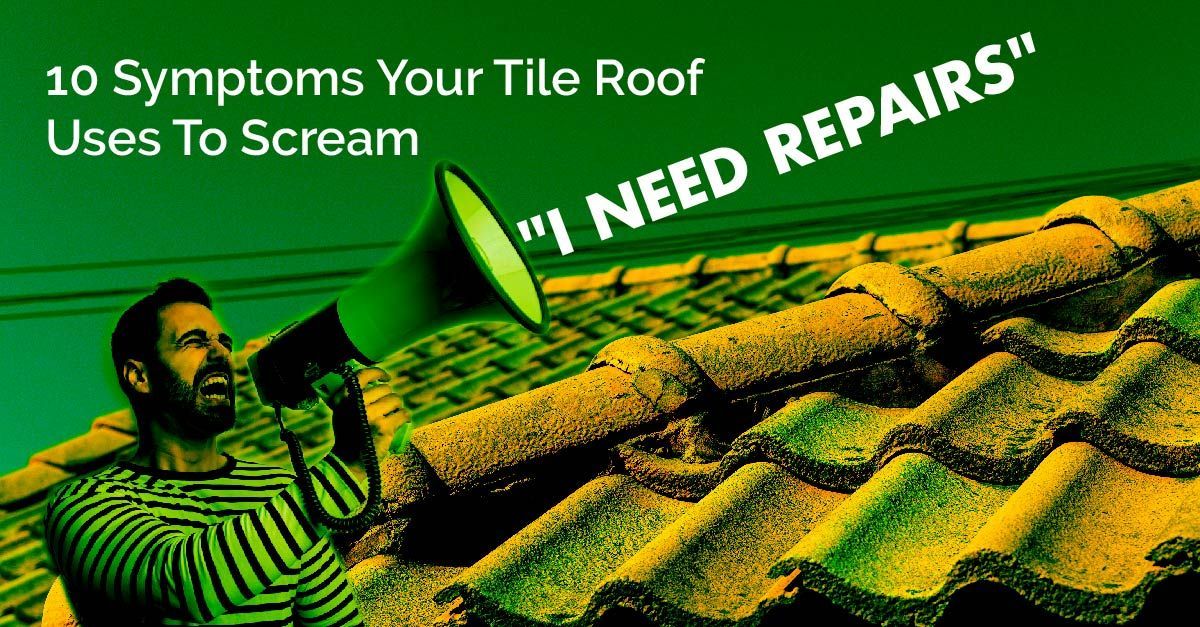With over a century of exemplary field performance in many parts of the world, tiles offer the longest lifespan as compared to other roofing materials such as asphalt shingles. Modern designs provide natural ventilation and water-shedding features, making tiles the preferred roof covering in both warm and cold climates. However, your tile roof needs special care and attention to last its full life of 50 plus years instead of 25 or less. Here are 10 signs your tile roof needs repairs in order to prolong its lifespan.
1. Water seepage from under the roof tiles
Concrete tiles rely on the underlayment to be 100 percent watertight. However, a new tile roof installation should not allow water to get underneath the tiles. If you notice water seeping under the roof tiles, it’s a sign your tiles or were improperly installed or your roof is getting old and should be repaired to extend its lifespan.
2. Cracked or missing tiles
South Florida exhibits frequent rains and storms, so it is common to see tiles crack or go missing. In most cases, broken or missing tiles can be handled easily and at a moderate cost. However, this problem could also be a sign your tile roof is getting old. Leaving it un-repaired for a longer period can open your roof to further and potentially more expensive roof damage, requiring costly repairs. The moment you notice cracked or missing tiles, have a reputable roofing contractor inspect the roof and advise you if the repair is minor or major.
3. Streaks on the fascia board
Black streaks on gutters and fascia boards just underneath the gutters are often a result of tar, tile, and other roofing material bonding to the gutters. These streaks will make your gutters and fascias look worn and old. Instead of spending a lot of money replacing the gutters every few years, you can have a professional roofer inspect the roof for hidden damage and correct the problem once and for all.
4. Interior ceiling stains
If you notice some damp patches or stains in your ceiling, it could be a sign of a leaking roof. Even the smallest watermarks on your ceiling should never be underestimated – it’s often a warning sign of water seeping in from the roof or a hole or crack in the roof. Don’t wait for further water damage which could require a new roof.
5. Musty smell in the house
Something else to check out for is the musty smell which is often a sign of mold growth. If mold has grown in your home’s interior or attic space, then most likely water or moisture is penetrating your roof. Have a roofing professional inspect the roof and seal any points of leakage. Deal with this as soon as you can to prevent bacteria and fungi from growing and causing health problems for your family members.
6. Algae buildup, especially in one area
Roof algae generally exhibit a black-green hue. Algae grow mostly on wood and concrete tiles, especially in humid areas without a lot of sunlight. The most common class of roof algae known as Gloeocapsa magma can gradually eat away tile roofs and cause costly roof damage. Have your roofer clean up any algae and repair any problems which could be causing water to pool on your roof.
7. Water drainage washing out flower beds or foundation
You probably work hard to make your landscaping look great. If you repeatedly invest time and money repairing water damage from malfunctioning gutters, consider investing in a gutter replacement.
8. Rooms have varying temperatures
Ideally, your HVAC system should keep every room of your house comfortable. If you notice temperature differences between rooms, it could be a sign of insufficient attic ventilation or a damaged, leaky roof allowing bad air in and good air out. Have the roof inspected for any sign of damage and repaired promptly.
9. Plants growing out of the roof
Fortunately, algae growth on your roof doesn’t always mean you need roof repairs or a replacement. However, moss growing on your tile roof can be an eyesore; it is extremely common in humid regions. Have your roofer clean your roof using a soft wash and environmentally-safe cleaning solution to remove the algae.
10. Discoloration of the wall or roof
When you inspect your attic and notice any dark streaks or stains on the walls or roof, it could indicate water damage. Have a professional roofer inspect the roof to determine the source of water infiltration and mitigate further damage to your home’s interior.
Ultimately, inspecting and maintaining your tile roof regularly will help it last up to twice as long. If your roof is showing any of these warning signs, you may need your roof repaired as soon as possible. Connect with Kelly Roofing in South Florida to complete a thorough roof inspection for you. We will give you a free estimate of what repairs your tile roof needs to extend its life. Never worry about your roof again!
